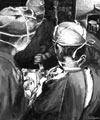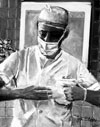The Art of Surgery
Paintings by Joseph R. Wilder, M.D.
(Page 1) |
(Page 2) |
Page 3
Click on the small painting with each description to see a larger version.
|

|
Sharp Dissection
This image captures what art critic Kuspit calls "Wilder's obsession
with the demanding intimacy (far beyond ordinary colleagueship)
of the operating room."
And says Koop of this series of works, "When I look at Joe's paintings,
I remember and feel once again" the aura of the OR. "The way
his figures stand, their body language, their very attitude propel from
the page into my mind. . . . At times I used to think, 'This is as close
as I will ever get to the precision of ballet dancing.'"
|
�
|

|
Concentration in Surgery �
"Intense concentration is the hallmark of successful surgery," explains
Koop. And Wilder himself believes "that the operating room
should be seen as a cathedral, in which all occupants must respect the
sanctity of the place. All attention must be focused on the patient
and the operative procedure. . . . A quiet ambience must be pervasive,
with the same respect that we show in our place of worship."
And art critic Kuspit, referring to a 19th-century painter of several
noted works with medical themes, says of Wilder, "This is not
Thomas Eakins looking in on an operation and trying to identify with
the surgeon, but the surgeon himself showing us—in great detail—
what it looks and feels like to practice surgery."
|
|

|
Deep in Surgery �
"The surgeon, like the priest, struggles with first and last things,"
points out Kuspit. The surgeon "is in the special position of the caretaker
and healer in a world which is not very caring and more pathological
than healing. Bodily illness may not be the wages of sin in
Wilder's pictures, as it was in medieval times, but it has a profound psychic
effect on both doctors and patients. Wilder's surgeons may not
be saints or priests, but he clearly views surgeons as heroes."
Yet the practical details of Wilder's paintings are also significant.
"There is a tendency for most of us to focus on the patient and surgery
team when we think of the operating room," the artist himself observes.
"However, there are numerous objects resting near the patient
that are lifesaving. . . . The simple bottle, tube, and needle are essential
for safe and successful surgery."
|
|

|
Threading the Needle
"Wilder uses the impressionistic-expressionistic
interplay of light and darkness to emotional effect,"
says Kuspit, "thus restoring Rembrandt's visionary
idea of significance.
"Wilder's surgeons are sturdy oaks," he adds, "but
they are also bamboo reeds that bend with the wind
and thus do not break. Surgery is necessarily realistic
and scientific, but it is also expressionistic and
artistic . . . which is no doubt why Eakins regarded
it as a model for realistic art and why Wilder regards
painting and surgery as parallel activities, for
both integrate hand and mind."
|
|

|
Removing Gloves
"Why is a work of art so enduring compared to the fleeting fame of the
event or subject it captures?" asks surgeon Starzl. "One reason may be that
students, teachers, and critics of art are preoccupied with the perpetuation,
refinement, and continuous reevaluation of what already has been done
or learned. An aura of history hangs heavy over a superb painting of a person,
an accomplishment, or even some simple thing."
Wilder himself observes about one of the seemingly "simple" elements
in this particular painting that "hands are the most difficult part of the human
anatomy to paint. Indeed, many artists fake them." Yet a surgeon's
hands, he adds, represent "coordination, beauty, and delicacy. For these
anatomical structures make the difference between poor, good, and great
surgeons. Good hands give you good surgery."
|
|

|
Recovery Room �
"It is in the numerous images in which Wilder
shows the surgeon . . . before or after the operation
that the depths of the surgeon's feelings become apparent,"
writes Kuspit. "It is then that his professional
and human pride become one—that the
tough-mindedness that he shows before operating
gives way to tenderness and warmth. Wilder's surgeons
have hearts as well as minds." �
|
�
(Page 1) |
(Page 2) |
Page 3
Back to Table of Contents
